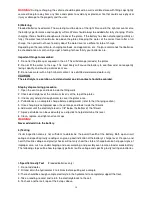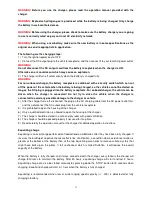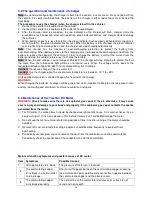
13
5. MAINTENANCE
Users should perform regular maintenance to ensure the vehicle is operating at optimum performance.
5.1 Maintenance of the Battery
NOTE:
Our standard vehicles are equipped with deep-cycle flooded lead-acid batteries. If your vehicle
is equipped with any other type of batteries, please follow the maintenance instruction by the battery
manufacturer. The maintenance instruction below is especially for deep-cycle flooded lead-acid
battery.
WARNING!
Battery electrolyte is poisonous and dangerous, and may cause severe burns, injury, etc…
Always wear protective clothing, gloves and goggles when handling batteries, electrolyte, and charging
your battery.
KEEP OUT THE REACH OF CHILDREN.
1. Cleaning
The exterior of the battery, the connection wires and bolts should always be kept clean and dry. When
cleaning, please make sure all vent caps are tightly in place. Clean the battery top with a cloth or brush and
solution of baking soda and water. When cleaning, do not allow any cleaning solution, or other foreign
matter to get inside of the battery. This should be done every week.
Clean the battery terminals and the inside of cable clamps using a post and clamp cleaner. Clean terminals
will have a bright metallic shine. This should be done when it is necessary.
Reconnect the clamps to the terminals and thinly coat them with petroleum jelly (Vaseline) to prevent
corrosion.
WARNING!
Before you disconnect any battery cable from any terminal on the battery, please always turn
off the power by disconnecting the main battery cable from the controller.
2) Checking the terminals and nuts
The connection of the battery should always be kept in good condition. Please check every week as to
whether any battery cable terminal or nut has become loose in order to prevent any spark or damage to
terminals. Please check every week whether any battery cable is damaged or not, any damaged battery
cable should be replaced immediately.
3) No foreign matter
Do not place any objects on the battery and do not connect the positive pole to the negative pole. This may
cause a short circuit, dangerous spark, or may cause damage to the battery or injury to the user.
4) Recharging
a
. As long as you use the vehicle, regardless of how long you have used it, the battery should be
recharged fully on the same day. Any delay in the recharging will cause a negative effect on the battery.
Note: the lead-acid battery does not develop a memory, so it does not need to be fully discharged before
recharging.
b.
If the vehicle is going to be kept unused for a long time, the battery should be fully recharged first. After
that, the battery should be fully recharged every 2 weeks.
c.
When driving, the driver should always be aware of the drop level of the battery power from the battery
power meter, any drop means the battery power is diminishing. Besides, the driver should estimate the
distance needed to be taken, and recharge the battery at a proper time in case that the vehicle cannot get
back to the recharging station in time for recharging.
WARNING!
Please make sure the battery is recharged before the battery power meter shows 20% power
is left. An over-discharged battery will have a very short service life and will make recharging very difficult.
Summary of Contents for Bubble Buddy
Page 5: ...5 Fig 2 Fig 3...
Page 29: ...29...





























